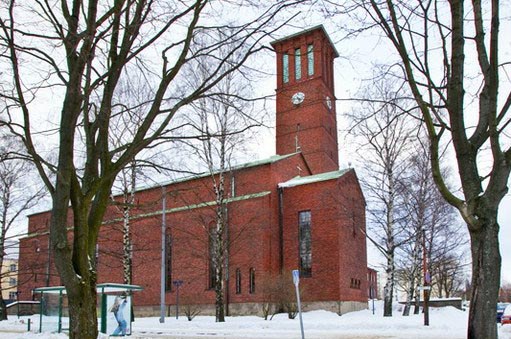St. Paul's church

The City of Helsinki donated the plot in the Vallila blue collar district for the church building in 1915. In spring 1928, a decision was made to build a church for a thousand people on the plot. Fifty-one contestants took place in the architecture contest. The proposal of architect, Bertel Liljeqvist, was chosen and taken as the basis for the church construction. The foundation stone of St. Paul's church was laid in autumn 1929, and the church was dedicated in March 1931.
The Winter War damaged the pillars of the main entrance and one wall. The traces of the war are still visible. The renovation of the church was completed in autumn 2003. The renovation which restored the church back to its original appearance was designed by the architecture practice, Slotte & Schütz.
On top of the entrance of the red-brick church stands the dedicated Saint of the church, Apostle Paul, holding a sword, which according to tradition refers to the way he died. According to Paul, the Word of God is also the Sword of the Spirit.
The front door handle has a cross, an anchor and a burning heart, depicting faith, hope and love.
The organ gallery has sentence from Psalm 100: ”Käykää hänen portteihinsa kiittäen” (Enter His gates with thanksgiving). The symbol of a pilgrim, a scallop shell, the symbol of the secret of faith, and a pearl, which describes the Kingdom of God as a valuable treasure, are repeated in the lamps of the side pillars and the pattern of the altar railing. The same symbolism was used by the designer of the church's new textiles, textile artist, Helena Vaari. The altar top is of ancient limestone, with fossils visible here and there.
The paintings in the church vault are by artist, Antti Salmenlinna. The church dome and the Lamb of God were painted by Ilmari Manninen. The abundantly decorated dome depicts Heaven. The suffering Lamb is carrying the flag of victory. On the choir ceiling is found the emblem of God, a gilded sun and the face of Christ, crowned with thorns. Above the altar hangs a wooden crucifix made by sculptor, Elias Ilkka.
The pulpit depicts the antecedents of the preachers of the gospel, the four evangelists, Matthew, Mark, Luke and John, by artist Gunnar Finne. In the ceiling or the pulpit, a pelican is feeding her young with her blood. This is an ancient emblem of the suffering of Christ and the love of God.
The art deco style communion set designed by artist, Henry Ericsson, was on display in the 1929 Barcelona International Exposition.
The main church organ was made by the Kangasala organ factory in 1931. In 2005, the organ builder, Veikko Virtanen, restored it to its original appearance. The organ has 48 stops and three keyboards. The choir organ, made by organ builder, Martti Porthan, in 2004, is of Italian style. It has 12 stops, one keyboard and an attached pedal.
St. Paul's Church is used by the Paavali parish. It is also possible to study the church virtually via the internet.
Celebrations at the church
Members of the church can organise a baptism, a wedding or a funeral free of charge in the church.
The church seats 800. The annexe of the church has two large parish meeting halls, Alasali (lower hall) and Yläsali (upper hall). Yläsali seats 80-100 people. Yläsali has a preparation kitchen (which corresponds to a domestic kitchen). Alasali seats 100-120 people and has an industrial kitchen. There is tableware for a hundred people. Table linen must be supplied by the party organiser: the size of the tables in 140x70 cm.






